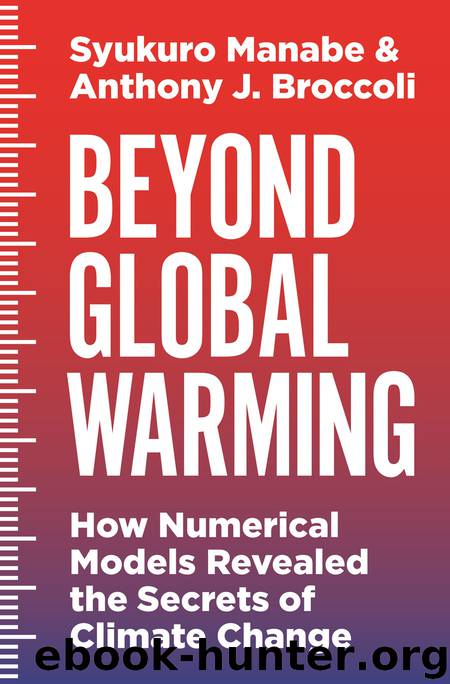Beyond Global Warming by Manabe Syukuro; Broccoli Anthony J.;

Author:Manabe, Syukuro; Broccoli, Anthony J.;
Language: eng
Format: epub
Publisher: Princeton University Press
Published: 2019-11-13T00:00:00+00:00
FIGURE 7.3 Schematic diagram illustrating (a) the correspondence between sea ice coverage and the latitudinal profile of SST at LGM and at present, and (b) the latitudinal profile of the glacial-interglacial SST difference (LGM − present).
In the numerical experiments performed here, the glacial-interglacial SST difference depends upon three factors: an expansion of continental ice sheets with high surface albedo, a reduction of CO2-equivalent concentration of greenhouse gases, and an increase in the albedo of the snow-free surface. In order to evaluate the individual contributions of these changes to the glacial-interglacial difference in SST, Broccoli and Manabe (1987) performed additional numerical experiments using the FC version of the model. In each experiment, they changed one factor at a time, thereby evaluating the contribution of each change to the total glacial-interglacial SST difference.
Figure 7.4 illustrates the latitudinal distributions of the individual contributions obtained from this set of experiments. The expansion of the ice sheets has a large impact on SST in the Northern Hemisphere, whereas it is small in the Southern Hemisphere, where glacial-interglacial difference in continental ice extent is small. As noted by Manabe and Broccoli (1985), the damping of SST perturbation through interhemispheric heat exchange is much weaker than the in situ radiative damping in each hemisphere and has little effect upon the magnitude of the perturbation in middle and high latitudes. The effect of the lowered greenhouse gas concentrations is comparable in magnitude between the two hemispheres, though it is substantially larger in the Southern Hemisphere. The contribution from land albedo is relatively small in both hemispheres. Expressed in another way, the expanded ice sheets have the largest impact in the Northern Hemisphere, followed by the lowered concentration of greenhouse gases. In the Southern Hemisphere, on the other hand, the reduced greenhouse gas concentration is mainly responsible for the SST difference. Averaged over the entire globe, both expanded continental ice sheets and reduced greenhouse gases have a substantial impact on global mean SST, whereas changes in land albedo over ice-free areas have only a minor effect on a global basis.
The geographic distribution of the glacial-interglacial SST difference obtained from the VC version of the model is compared with the CLIMAP reconstruction in figure 7.5 as an example. In general, the model simulates reasonably well the broad-scale pattern of the SST difference. For example, regions of relatively large SST difference appear in the zonal belt of the Southern Ocean and in the northern North Atlantic Ocean, where the LGM sea ice margins are located, consistent with the schematic diagram shown in figure 7.3.
Download
This site does not store any files on its server. We only index and link to content provided by other sites. Please contact the content providers to delete copyright contents if any and email us, we'll remove relevant links or contents immediately.
Man-made Catastrophes and Risk Information Concealment by Dmitry Chernov & Didier Sornette(4735)
The Revenge of Geography: What the Map Tells Us About Coming Conflicts and the Battle Against Fate by Kaplan Robert D(3597)
Zero Waste Home by Bea Johnson(3290)
COSMOS by Carl Sagan(2950)
In a Sunburned Country by Bill Bryson(2946)
Good by S. Walden(2915)
The Fate of Rome: Climate, Disease, and the End of an Empire (The Princeton History of the Ancient World) by Kyle Harper(2436)
Camino Island by John Grisham(2383)
A Wilder Time by William E. Glassley(2363)
Organic Mushroom Farming and Mycoremediation by Tradd Cotter(2307)
Human Dynamics Research in Smart and Connected Communities by Shih-Lung Shaw & Daniel Sui(2178)
The Ogre by Doug Scott(2114)
Energy Myths and Realities by Vaclav Smil(2060)
The Traveler's Gift by Andy Andrews(2011)
Inside the Middle East by Avi Melamed(1939)
Birds of New Guinea by Pratt Thane K.; Beehler Bruce M.; Anderton John C(1906)
Ultimate Navigation Manual by Lyle Brotherton(1767)
A History of Warfare by John Keegan(1714)
And the Band Played On by Randy Shilts(1615)
